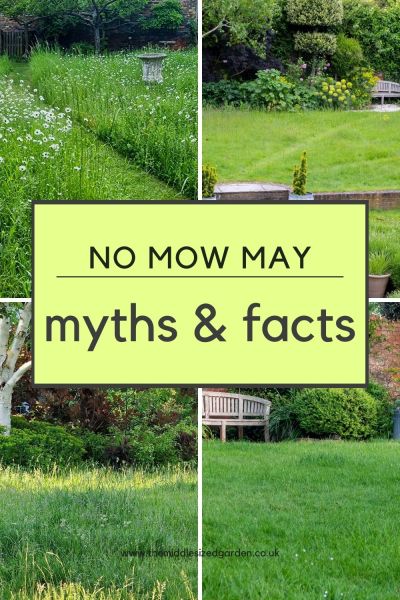The basic idea of No Mow May is simple. Just don’t mow your lawn in May, which allows some wildflowers and weeds to bloom. This provides valuable nectar and habitat for pollinators just when they are hatching or coming out of hibernation. And they in turn are a food source for birds, bats and other wildlife.
And it saves you time and effort.
It’s an initiative started by the charity, Plantlife. It has now spread all over the world.
‘Your lawn is an eco-system,’ says Plantlife. There’s a complex network of funghi, worms and microbes in the soil. And the grass above has the potential to feed and shelter a wide range of wildlife.

Lawns that are over-treated and mown very short don’t offer as many environmental benefits as gardens with longer grass.
No Mow May is an opportunity to find out what living with a less-than-perfect lawn might be like. I think one main advantage is that it is an experiment in approaching lawn care differently, not a commitment.
In some places, growing your lawn grass longer is not permitted. If you live in an area known for wildfires, then longer grass in dry weather will be either forbidden or unwise. There are also places where your lawn height is regulated by bye-laws. You’ll have to change your local regulations if you want to grow your grass longer.
However, many of the other No Mow May ‘problems’ are not necessarily confirmed by scientific research.
This will be my third year of doing No Mow May, so this post is based on both personal experience and research.
What to think about before starting
Guy Jenkins of Johnson’s Lawn Seed says that you should firstly think about what you use your lawn for. If you have children who play ballgames on it, for example, then letting your whole lawn grow long is not necessarily going to be the best option for you.
He recommends leaving part of the lawn to grow long rather than the whole lawn.
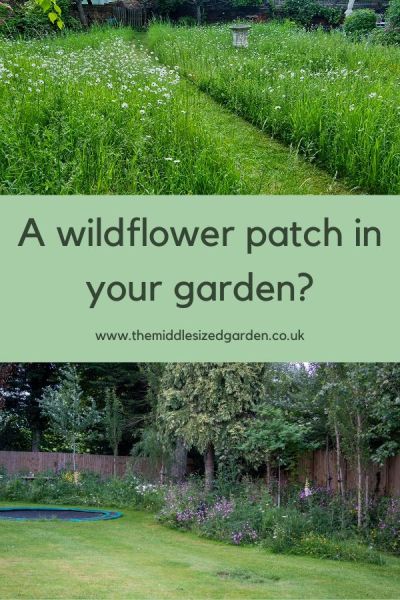
You can leave a part of your lawn to grow long. Both of these long grass areas have been deliberately created as mini meadow areas. You will need to learn about how to turn lawn into meadow as it does require more than just letting the grass grow. But letting some areas grow long in No Mow May could be an easy way of starting to experiment with it?
‘Think about what wildlife really needs,’ says Guy. ‘They’re more likely to use a strip of longer grass that’s near to shelter, for example along a hedge or fence line, rather than an exposed area in the centre of the grass. Contrast looks good too – a drift of long grass and flowers can look good surrounded by cut lawn.’
This is echoed by wildlife garden expert Joel Ashton in 5 easy wildlife garden tips. He says that people often place bird feeders in the middle of gardens. However, birds need feeders to be close to shelter so they can make a quick escape if predators appear when they’re feeding.

A mix of short and longer grass at West Dean Gardens in Sussex. The top photo shows a deliberately created strip of meadow, while the photo below it shows long grass left to grow under old fruit trees. The adjacent lawn is mown.
Is a lawn bad for the environment?
Some people will tell you that you must keep your lawn smart with weekly mowing, using weed-killers, moss killers and fertilisers. Others will say you don’t need all those chemicals and mowing. And a third group now declare that lawns are ‘green deserts.’
Only you can decide what works for your garden. However, as David Hedges-Gower of the Lawn Association says ‘A lawn is made of thousands of plants.’
Planting thousands of plants is always a good start if you want to be environmentally friendly. But you need to choose the right plants, which will grow well in your area.
A lawn absorbs rainwater and helps stops urban drains from flash flooding. It also absorbs heat, pollution and carbon dioxide, and provides a home for worms and soil micro-organisms.
However, regular petrol mowing and/or irrigation plus the use of fertilisers and insecticides can cancel out those environmental benefits.
Lawns are good for some environments, not for others…
Some climates are not suitable for lawns. Whenever I check the research behind the ‘lawns are green deserts’ articles and posts, I note that it is carried out in hotter, drier climates, usually in the Southern parts of the USA. In some parts of America, watering the lawn accounts for a high percentage of water use.
In the UK and in other mild climates, hardly anyone waters their lawns, even in the driest areas like mine.
Another problem is that US lawns mainly use grasses derived from European imports. In the wrong climate and soil, you may have to work hard to keep these looking good.
In the UK, many of our lawns are made from native bents and fescues. They’ll thrive on quite a bit of neglect.
So, as with all gardening, it’s ‘right plant, right place.’
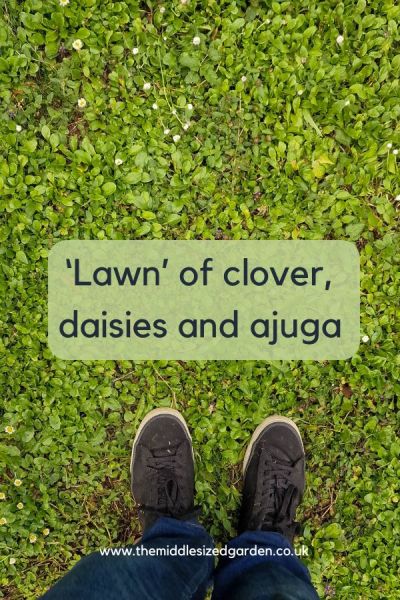
This is a garden I visited earlier this year. I noticed that we were walking across something that looked like a lawn, but it was actually clover, daisies and ajuga.
Can I mow before No Mow May?
Yes, the charity Plantlife, says that many wildflowers emerge best from a short lawn. Mow your lawn as usual in April unless you are encouraging spring wildflowers.
I have two patches of mini-meadow in my front garden. These are for spring flowers, such as wild tulips and daffodils, primroses and violets. I’m planning to add cowslips. So I won’t mow these two patches until mid to late summer.
When I spoke to head gardener of Great Dixter, Fergus Garrett, he said that diversity is the key to increasing biodiversity. Some species need short grass and others need longer. Both approaches can be wildlife friendly.
And in The Book of Wilding by Isabella Tree and Charlie Burrell, they say that short grass mimics meadow areas grazed by herbivores. There is a role for short grass in wildlife friendly gardens.
Some people believe that a lawn is a ‘fashion’. But botanist James Wong says that human beings are descended from forest edge dwellers. We instinctively feel most at home with trees behind us and an area of open grassland ahead.
In this context, ‘the lawn’ is as old as humankind.
Please note that links to Amazon are affiliate, see disclosure.
What happens once you stop mowing the lawn?
Not much happens in the first two weeks. The grass will get a bit longer.
You won’t get a lawn full of beautiful wild flowers. If you do want a meadow lawn with wildflowers, you will have to actively create one, not just stop mowing. See how to create a mini meadow garden.
Some friends of mine once sowed meadow wildflower seed in their empty raised beds. It created a ‘raised bed meadow’ and looked beautiful for months at a time. This year, I’m going to do this in my raised veg beds instead of the grow-your-own. I’ll report back.
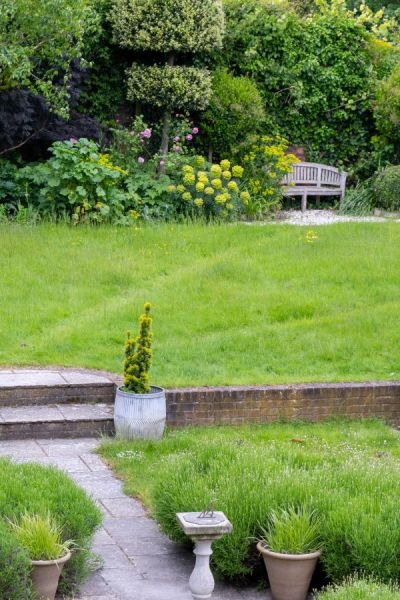
My lawn after 31 days of No Mow May. You can just see a patch of buttercups near the bench and closer up you can see clover flowering. Many lawns are designed to have a percentage of clover in them, so they are not ‘weeds’.
Which flowers do you get in No Mow May?
In the second two weeks, some flowers will start to appear. In my garden, this is daisies, dandelions, buttercups, clover and yarrow. They have been joined by primroses and violets.
Guy Jenkins says that if you have a fairly new lawn, it’s unlikely to have any flowers emerging. It will just be all grass.
Throwing packets of wildflower seed into the lawn won’t help because lawn grass is very dense and it’s hard for seeds to establish.
So you won’t get the glorious meadow of wildflowers promised by some advocates of No Mow May.
But, for exactly the same reason, your garden is unlikely to be ‘overwhelmed with weeds’, as predicted by some critics of growing lawn grass long.
Yes, you’ll get a few more weeds in May if you stop mowing. When you start mowing again, the grass thickens up and starts to out-compete the weeds again. We do have more daisies and dandelions than we did, but they haven’t ‘overwhelmed’ the lawn grass. Nor are they likely to.
By the end of the four weeks, my lawn grass was about 6″ high. Some people would think it just looks overgrown.
But I loved the way that the garden seemed to be humming with life when I went out first thing in the morning. There seemed to be more birdsong.
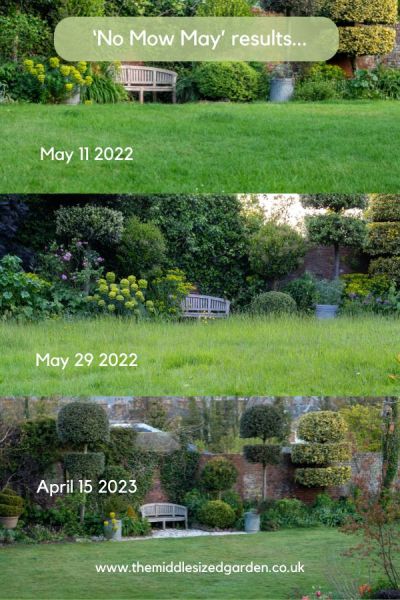
What the lawn looks like a year after No Mow May. As you can see, the grass is longer in May, but is not necessarily a ‘meadow.’ However, the lawn, one year on, is fine. We have never used fertiliser or weed-killer on it, and we mow every 2-3 weeks except in winter or during a drought when we don’t mow at all. It hasn’t been overwhelmed with weeds, although it certainly isn’t a perfect lawn.
So why could No Mow May be a bad idea?
Some people say that growing your grass long will encourage ticks.
There has been an increase in ticks in gardens. Experts believe that this is mainly due to an increase in deer visiting gardens, as deer are major carriers of ticks.
Ticks are also more associated with woodland areas than long grass. They need moist conditions and longer grass can be too dry.
There has been scientific research done by the US Department of Agriculture (Forest Service), published in Science Daily. It looked at whether ticks increased in suburban gardens if the lawn was allowed to grow long. At the end of the study, no ticks were found in any of the gardens.
Of course, one piece of research isn’t enough. Ticks carry some serious diseases. If you have deer visiting your garden or you live in a wooded area, you should be ‘tick aware’ regardless of what you decide to do with your lawn.
I have only ever got ticks from one garden. It had lots of trees but not much lawn and virtually no long grass
Ticks in gardens is an issue, and one we should all stay aware of.
But, so far, it seems likely to be a No Mow May myth.
What happens after No Mow May?
There are two aspects to this. Firstly, what happens to the wildlife that has enjoyed your longer lawn? Have you encouraged it to flourish only to abandon it to a cruel world?
By June, the natural world is in full summer mode. There is more greenery, flowers and habitat than earlier in the year. When you cut your lawn, wildlife has a good chance of finding alternative habitats and food sources.
And you can actively garden for biodiversity, making sure your borders have wildlife-friendly plants in them. It doesn’t have to be a wild-looking garden, as you can see from Great Dixter’s beautiful yet biodiverse borders.
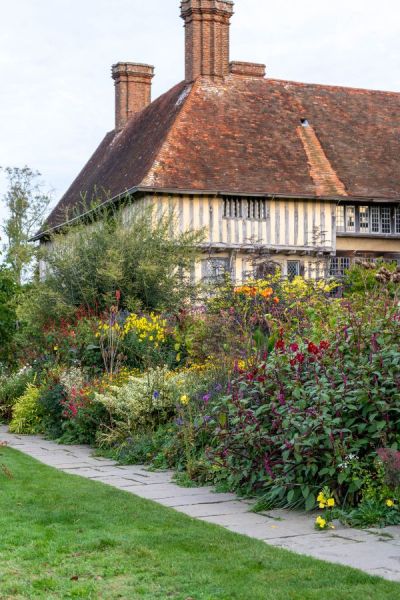
Great Dixter is known for combining beautiful borders with biodiversity. It has both short lawns and longer grass in different parts of the garden.
When it comes to the actual mowing, Plantlife recommend that you mow from the centre of the lawn, working towards the edges. This gives small creatures, like frogs and toads, a chance to escape.
If you mow all the way round the edges to the middle, then you could trap these in the centre.
Will I be able to get my lawn ‘back’?
Secondly, we have all read or seen dire warnings of what will happen to your lawn after No Mow May. I have seen the word ‘catastrophic’ used.
The problem is this. You place the lawn under strain by letting the grass grow long, then chopping it very short in one day. That will take off most of the grass ‘leaf’ area and leave just the brown stalks.
If June is then a dry month, your grass will struggle to grow. Weeds will find it easier to establish in the bare patches left.
However, Guy Jenkins says you can avoid placing your grass under this strain by mowing it on the highest setting for the first cut. ‘Then leave it at least a week before doing the second, shorter cut.’ This allows the grass to re-grow shorter leaves before it’s cut really short. Catastrophe averted!
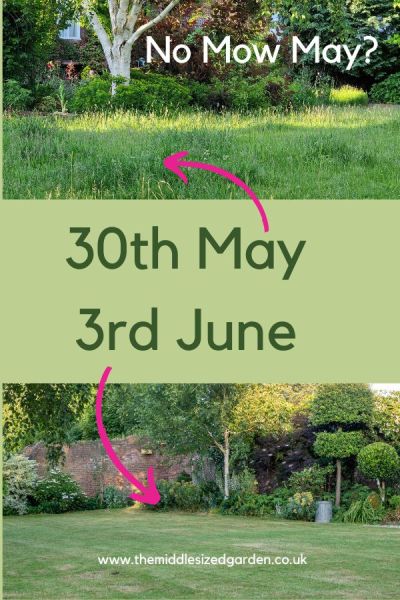
What happens after No Mow May? We did cut our lawn down to short in one day, leaving some brown patches. But they recovered quickly as there was rain in June. You can avoid this by doing one longer cut and then a short one a week later.
He also warns that if you let your lawn grow even longer – says for 2-3 months, then standard mowers may struggle to do the first cut. You may need to scythe or chop it down roughly first, then use a mower.
I have to admit that we cut our grass completely short in one day, although this year I will follow Guy’s advice. We have done No Mow May for two years. The first one was two months before the hottest summer ever recorded in the UK, and there was also a drought.
But luckily there was rain in June and the very short brown patches had recovered. We didn’t mow it during the drought – and that’s important. Grass virtually stops growing in very dry weather, so you shouldn’t need to mow your lawn.
Longer grass is also more drought resilient. You don’t need to water an established lawn. It goes brown, then bounces back when the rain comes.
What can you do instead of No Mow May?
If you’d like to have a more wildlife friendly lawn, but don’t want a month of longer grass, you can just mow less.
A tightly mown lawn will be about 2″ high but you’ll need to mow weekly to keep it that way, especially if the weather is warm and wet.
But if you keep it a little longer – up to around 4″, you won’t have to mow so often. This will enable small flowers like clover and daisies to flower ‘beneath the mower’. It’s less work for you.
I was recently reading a vintage gardening book. It referred to the ‘fortnightly mow.’ Mowing weekly may be quite a modern habit.
You can also stop using weedkillers and fertilisers. If you sometimes leave the lawn clippings on the lawn, they will rot down and fertilise the lawn.
And you can hand-weed. If your lawn grasses grow well in your area, then they are quite good at out-competing weeds.
Once again, if a lawn gets too many weeds, it may be that the grass type itself isn’t right for your area. Consider changing your grass seed.
Which lawn is right for you?
There’s more here about whether you need a perfect lawn and how you make it more sustainable.
But I will certainly be doing No Mow May again this year.
Above all, I think it helps you realise that your lawn is resilient, that it doesn’t matter if it’s not perfect. And you don’t have to mow it regularly if you don’t want to.
